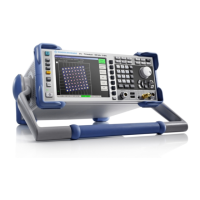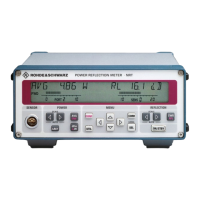R&S FSH Using the Markers
1309.6275.12 4.29 E-2
Deactivating markers or delta markers one at a time:
Press the SELECT MARKER softkey repeatedly
until the desired marker is highlighted in red.
The value entry field for the selected marker appears.
Press the DELETE MARKER softkey.
Now confirm the menu entry DELETE SELECTED
by pressing ENTER.
This deletes the selected marker.
Note: If marker 1 (M1) is deactivated, the R&S FSH also deactivates all delta markers, because
they use marker 1 as a reference.
Deactivating all markers or delta markers:
Press the DELETE MARKER softkey.
Using the rotary knob or the cursor keys select
DELETE ALL DELTA or DELETE ALL
Press the ENTER key or the DELETE MARKER
softkey to switch off all markers and delta markers.
Note: When the markers are deactivated, the R&S FSH also deactivates all delta markers,
because they use marker 1 as a reference.
Marker functions
Apart from displaying the level and frequency at the marker position (NORMAL setting), the R&S FSH
can also perform other forms of analysis at the marker position. For example, the R&S FSH can
calculate the noise power density referred to 1 Hz bandwidth (NOISE function) or measure the
frequency of a signal at the marker position (FREQ COUNT function). The filter bandwidth or the signal
bandwidth is measured with the N DB DOWN function.
Measuring the noise power density
The NOISE function is used to calculate the noise power density at the marker position. The R&S FSH
calculates the noise power density in dBm/(1 Hz) from the trace pixel values, the selected resolution
bandwidth, the detector and the level display mode (absolute or relative). To stabilize the noise power
display, the R&S FSH uses the pixel on which the marker is positioned and the four pixels to the right
and the four pixels to the left of the marker pixel. Noise power density can provide useful information
when measurements are made on noise or digitally modulated signals. However, valid results are
obtained only if the spectrum in the vicinity of the marker has a flat frequency response. The function
gives incorrect results if measurements are made on discrete signals.

